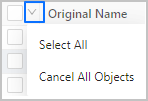Log on to OceanBase Developer Center (ODC) and click the name of the target connection to go to the corresponding database object management page. Click Recycle Bin in the upper-right corner to go to the recycle bin page.
The recycle bin temporarily stores deleted database objects and allows you to search for and restore the deleted objects.
Technically, the recycle bin is a data dictionary table that stores the information about deleted database objects. Deletion here refers to the DROP operation. Data that is deleted by the DELETE operation will not be moved to the recycle bin. Therefore, an object deleted by the DROP operation is not permanently deleted and still occupies storage space. You can use the PURGE operation or empty the recycle bin in ODC to release the space.
The following figure shows the recycle bin page.
Column | Description |
|---|---|
Original Name | The name of the deleted object specified by its creator. You can click Original Name to sort the objects by original name in ascending or descending order. |
Object Name | The name that ODC gives to the object. Unlike the original name, the object name is never repeated and can uniquely identify an object. |
Object Type | The type of the deleted object. |
Recycled At | The timestamp when the object was deleted. The timestamps help you track deleted objects with ease. |
In addition, the navigation bar on the recycle bin page provides buttons with the following features.
Feature | Description |
|---|---|
Clear | Click |
Refresh | Click |
Purge | Click |
Restore | Click |
Search | Enter the name of a deleted object in the search box to search for it. |
Settings | Click
|
Select All | Click the check box icon  |
 to clear the recycle bin so that all the deleted objects in the recycle bin are purged and the storage space is released.
to clear the recycle bin so that all the deleted objects in the recycle bin are purged and the storage space is released.  to refresh the list of deleted objects in the recycle bin.
to refresh the list of deleted objects in the recycle bin.  to purge the selected objects from the recycle bin and release the storage space.
to purge the selected objects from the recycle bin and release the storage space.  to restore the selected objects from the recycle bin to its original location.
to restore the selected objects from the recycle bin to its original location.  to specify whether to enable the recycle bin and the Truncate Table feature.
to specify whether to enable the recycle bin and the Truncate Table feature.  to select or deselect all objects.
to select or deselect all objects.